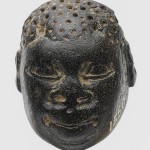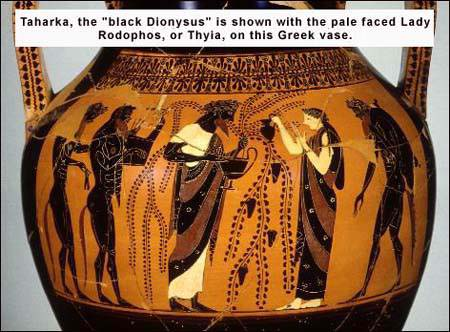
By Jide Uwechia with cited sources
The Benin Haplogroup or Haplogroup 19 Common in Africans, southern Greeks, Sicilians, and Albanians
There are at least four distinct African, (known as Senegal, Congo, Benin, Bantu Hbs Haplogroups) and one Asian chromosomal backgrounds (haplotypes) on which the sickle cell mutation has arisen.
The Benin haplotype (which originates from Nigeria, West Africa) accounts for HbS associated chromosomes in Sicily Northern Greece, Southern Turkey, and South West Saudi Arabia, suggesting that these genes had their origin in West Africa. The Asian haplotype is rarely encountered outside its geographic origin because there have been few large population movements and Indian emigrants have been predominantly from non HbS containing populations. Per:Graham R. Serjeant, MD, FRCP, The Geography Of Sickle Cell Disease:Opportunities For Understanding Its DiversityRSITY: http://www.kfshrc.edu.sa/annals/143/rev9239.html
Nigeria, west Africa appears the most logical origin of the sickle mutation in Greece evidence from beta S globin gene cluster polymorphisms (1991). It has been conclusively demonstrated that HbS in Greece is mostly haplotype #19 (the one that originated in Benin, Nigeria West Africa). See, Boussiou M, Loukopoulos D, Christakis J, Fessas P.; The origin of the sickle mutation in Greece; evidence from beta S globin gene cluster polymorphisms. Unit for Prenatal Diagnosis, Laikon Hospital, Athens, Greece.
Additionally, previous data suggest that the S/Bantu haplotype (from Southern Africa) is heterogeneous at the molecular level. Recent studies also report a similar heterogenity for the Benin Haplogroup. A study demonstrated the presence of the A -499 TA variation in sickle cell anemia chromosomes of Sicilian and North African origin bearing the S/Benin haplotype (from Nigeria). Being absent from North American S/Benin chromosomes, which were studied previously, this variation is indicative for the molecular heterogeneity of the S/Benin haplotype. Am. J. Hematol. 80:79-80, 2005.
A study was done in Albania (which borders Greece) relating to sickle cell anemia, sickle cell beta-thalassemia, and thalassemia major in Albania. The focus of the study was the characterization of sickle cell mutations. As one would expect, it was shown that the HbS mutation in the Albanian sample is the Benin (Nigeria)-originating haplotype #19. See, Boletini E, Svobodova M, Divoky V, Baysal E, Dimovski AJ, Liang R, Adekile AD, Huisman TH.; Sickle cell anemia, sickle cell beta-thalassemia, and thalassemia major in Albania: characterization of mutations. : Hum Genet. 1994 Feb;93(2):182-7.
According to a study done in 1973, before the availability of the advanced data cited above, “the occurrence of the sickle-cell trait in southern Europe …. is believed to reflect gene flow from the Middle East.” See A. P. GELPI, M.D, “Migrant Populations and the Diffusion of the Sickle-Cell Gene” August 1, 1973 vol. 79 no. 2 258-264 http://www.annals.org/content/79/2/258.abstract.
The problem with this 1973 study is that it assumes that the sickle cell genes came with the Arabs. Alas, updated research work has proven beyond doubt that the sickle cell genes proven to exist in southern Europe are exclusively Sickle cell gene Haplotype 19 or the Benin Sickle cell gene from Nigeria.
Y Haplogroup E-M78 and YAP In Black Africans and Greeks
Y Haplogroup E-M78 a derivative of E3B is a signature African gene as confirmed in research studies over the last few years. The high frequency of this haplogroup in Greece suggests the presence of a substantive African population in that region during prehistoric and historical time periods.
A recent paper has detected clades of haplogroups J and E3b that were likely not part of pre-historic migrations into Europe, but rather spread by later historical movements. Greeks .. [then there is] the marker J-M267, which may reflect more recent Middle Eastern admixture.
(Semino et al., Am J Hum Genet, 2004) E3b originates from East Africa while there is a high frequency of J-M267 in the East Coast of Africa as well as the Red sea coast of Arabia.
A recent sampling of the Greek population comprised 36 Peloponnesian samples, 5 of which were J-M172(xM12) and 17 of which were E-M78 (R.K., unpublished data).
In spite of the small Peloponnesian sample size, the high E-M78 frequency (47%) observed here is consistent with that (44%) independently found in the same region (Di Giacomo et al. 2003) for the YAP chromosomes harboring microsatellite haplotypes A. (Novelletto, personal communication) (Cruciani et al. 2004).
The study by by Di Giacomo et al. found the following African haplogroups in Greeks: Haplogroup A which is highly specific to West Africa, R1a, DE, and J2*(xDYS413= 18)J*(xJ2). R1* which probably gave rise to R1a is found in Northern Cameroon. DE is found principally among Nigerians and it is suspected that it originated from Nigeria. J is very prominent in East, and North Africa.
High-resolution Y-chromosome haplotyping and particular microsatellite associations reveal … an East Africa homeland for E-M78.Origin. See Ornella Semino, Chiara Magri, et al “Diffusion, and Differentiation of Y-Chromosome Haplogroups E and J: Inferences on the Neolithization of Europe and Later Migratory Events in the Mediterranean Area” http://www.pubmedcentral.nih.gov/articlerender.fcgi?tool=pubmed&pubmedid=15069642
HLA Genetic Relationship Between Ancient Greeks and Black Africans
HLA genes are reliable markers of past population movement and are still used in laboratories today to establish genetic inter-relationship amongst seemingly diverse peoples.
HLA genes in Macedonians and the sub-Saharan origin of the Greeks (2001) was a study conducted by Dr. Arniaz and other scholars in a top flying Spanish University. This study uses HLA genes to establish the African dimension of the roots of ancient Greece.
According to the Arniaz study, …Greeks are found to have a substantial relatedness to sub-Saharan (Ethiopian) people, which separate them from other Mediterranean groups. Both Greeks and Ethiopians share quasi-specific DRB1 alleles, such as *0305, *0307, *0411, *0413, *0416, *0417, *0420, *1110, *1112, *1304 and *1310. Genetic distances are closer between Greeks and Ethiopian/sub-Saharan groups than to any other Mediterranean group and finally Greeks cluster with Ethiopians/sub-Saharans in both neighbour joining dendrograms and correspondence analyses. The time period when these relationships might have occurred was ancient but uncertain and might be related to the displacement of Egyptian-Ethiopian people living in pharaonic Egypt. See Arnaiz-Villena A, et.al: HLA genes in Macedonians and the sub-Saharan origin of the Greeks. Tissue Antigens. 2001 Feb; 57(2): 118-27
There is a fraudulent claim (by those with idealogical investments in the topic) on the Internet that this study has been “retracted” or “refuted.” The study is perfectly valid. Sub-Saharan-specific and quasi-sub-Saharan-specific alleles were definitely detected in the Greek population at the DRB1 locus, and this is not open to question.
It would be helpful here to discuss the study that was retracted, and the reason why. It is the work titled: “The origin of Palestinians and their genetic relatedness with other Mediterranean populations” (which contained some cross-referenced Greek data in a neighbor-joining dendogram and a correspondence analysis) that was retracted. And it was retracted solely and strictly for political reasons, as this Observer article makes crystal clear:
http://www.guardian.co.uk/Archive/Article/0,4273,4307083,00.html
(Keep in mind we are dealing with the study on the relatedness of Jews and Palestinians at the moment, which was retracted, and not the one on the Greek-Black African relatedness, which was not retracted and remains valid. The two must not be confused.)
Appreciations to: http://onedroprule.org/about1071.html
Epilogue:
“Hb S is common in some areas of the Mediterranean basin, including regions of Italy, Greece, Albania and Turkey (Boletini et al., 1994) (Schiliro et al., 1990). Haplotype analysis shows that the Hb S in these areas originated in Africa. The genes probably moved along ancient trading routes between wealthy kingdoms in western Africa and the trade centers in the Mediterranean basin.” (Harvard University, http://sickle.bwh.harvard.edu/scdmanage.html)
“Usually, people with sickle cell disease outside Africa (e.g., blacks in the United States) or India have mixed haplotypes for their sickle cell genes.” (Harvard University, http://sickle.bwh.harvard.edu/scdmanage.html)
“Templeton gives a modern-day analogy: the presence of a gene for sickle cell anemia in Caucasians in Portugal. The gene traces back to a mutation that occurred in Africa and spread through interbreeding between Africans and Europeans. “The Africans didn’t come up, reconquer the Iberian peninsula, kill off all the Europeans, and that’s why there are sickle cell alleles in Portugal today,” he says. The presence of the sickle cell gene in Portugal “means that Portuguese and Africans have met and they’ve interbred, just like humans tend to do.” – “Out of Africa” – Ruth Flanagan, Contributing Editor, Earth Magazine, http://www2.mc.maricopa.edu/anthro/l…ofAfrica5.html




Orphesus
You wrote as follows:
As for E-M78.. I know very well the origin of E-M78..”
I want the answer: what is the origin of E-M78??
Answer will be found here: http://www.google.ca/search?hl=en&q=E-M78+origin&meta=
Does that resolve your problem???
If E-M78 arose in Africa and was in Southern Europe and the Mediterranean by 14 KYA according to you…doesn’t that demonstrate to you the antiquity of African/Ethiopian presence in Europe?
“…the problem, your problem (sic)to be exact is that you either are totally incapable of comprehending the very simple english in which Seminio’s paper is written or we turn to the logical conclusion which is that her research is totally indifferent to your inferiority complex, hence why you resorted to intentionally distorting it.”
Perfect lines written by a stupid moron to describe his true motivations.
Jahdey
Paragraph 4.. LOL Child I don’t care how the author distorted the paper since his intentions are more than obvious. As I told you prior to allegedly presenting a citation of any paper the first thing you should do is read and comprehend the damn thing and you’ve proven time and time again to be either incapable of doing so or simply too damn brainwashed by those that “sent you” to see that you’re making a fool of yourself.
The article above claims origin of ANCIENT Hellenes.. Yes!?!
Now read and tell me how the hell does a paper that speaks of LAST MILLENIUM support his audacious claims ?
>>Comparison of the above results with similar surveys in other parts of the world and consideration of various historical events suggest that the beta S mutation was introduced into Greece over the last few centuries by the Saracen raids and/or by settlements of North African slaves brought in by the Arabs, Franks, Venetians, or Ottoman Turks, who have occupied the country over the last millennium.<>The factor in common to the distribution of the sickle cell gene is therefore malaria and not African ancestry.<>the clinal frequency distribution of E-M78a
within Europe testifies to important dispersal(s), most
likely Neolithic or post-Neolithic. These took place from
the Balkans, where the highest frequencies are observed,
in all directions, as far as Iberia to the west and, most
likely, also to Turkey to the southeast. Thus, it appears
that, in Europe, the overall frequency pattern of the haplogroup
E-M78, the most frequent E3b haplogroup in
this region, is mostly contributed by a new molecular type
that distinguishes it from the aboriginal E3b chromosomes
from the Near East. These data are hard to reconcile
with the hypothesis of a uniform spread of a single
Near Eastern gene pool into southeastern Europe. On the
other hand, they might be consistent with either a smallscale
leapfrog migration from Anatolia into southeastern
Europe at the beginning of the Neolithic or with an expansion
of indigenous people in southeastern Europe in
response to the arrival of the Neolithic cultural package<<
So the ALPHA CLUSTER which is the cluster found in Greece is either a Balkan region specific cluster from which it spread throughout Europe or it “leap-frogged” to the Balkans from Anatolia..
When did this take place?
See page 17 and read 7.8KY which means approx. 8.000 and yes my illiterate little friend that is THOUSAND YEARS AGO.
So the question is, even if it was an African marker (WHICH IT ISN’T) how do you intend to justify your claims on a people whom you yourself claim appeared only 3000yrs ago.. what happened with the 5000yr GAP (which is even bigger than your previous claims)?
Conclusions:
a) Sickle Cell IS NOT related to ancestry !!!
b) the paper (Loukopoulos) you’ve rediculously used to claim ancient Hellenes speaks of LAST MILLENIUM
c) E-M78 ALPHA CLUSTER is either a local or Anatolian imported during the NEOLITHIC cluster.
PS: try to understand that your pathetic display of petty provocations through the distortion of my screen name only adds to your ridicule.
Disregard or delete the previous since it got screwed up during the copy/paste.
Last try…
Paragraph 4.. LOL Child I don’t care how the author distorted the paper since his intentions are more than obvious. As I told you prior to allegedly presenting a citation of any paper the first thing you should do is read and comprehend the damn thing and you’ve proven time and time again to be either incapable of doing so or simply too damn brainwashed by those that “sent you” to see that you’re making a fool of yourself.
The article above claims origin of ANCIENT Hellenes.. Yes!?!
Now read and tell me how the hell does a paper that speaks of LAST MILLENIUM support his audacious claims ?
>>Comparison of the above results with similar surveys in other parts of the world and consideration of various historical events suggest that the beta S mutation was introduced into Greece over the last few centuries by the Saracen raids and/or by settlements of North African slaves brought in by the Arabs, Franks, Venetians, or Ottoman Turks, who have occupied the country over the last millennium.<<
I won’t get into the historical inaccuracies of Saracen raids which were limited to a single island, to that of Skiathos, nor the claim of a non-existant Arab rule not even to the non-recorded African slaves.. but strictly centralize on the FACT that you present a paper that speaks of LAST MILLENIUM while making claims on ANTIQUITY !!!
Lets hope you finally understand that the 1500yr GAP simply trashes your every claim.
Graham’s paper:
you intentionally omit to mention is that he clearly states in the 2nd paragraph:
>>The factor in common to the distribution of the sickle cell gene is therefore malaria and not African ancestry.<>the clinal frequency distribution of E-M78a
within Europe testifies to important dispersal(s), most
likely Neolithic or post-Neolithic. These took place from
the Balkans, where the highest frequencies are observed,
in all directions, as far as Iberia to the west and, most
likely, also to Turkey to the southeast. Thus, it appears
that, in Europe, the overall frequency pattern of the haplogroup
E-M78, the most frequent E3b haplogroup in
this region, is mostly contributed by a new molecular type
that distinguishes it from the aboriginal E3b chromosomes
from the Near East. These data are hard to reconcile
with the hypothesis of a uniform spread of a single
Near Eastern gene pool into southeastern Europe. On the
other hand, they might be consistent with either a smallscale
leapfrog migration from Anatolia into southeastern
Europe at the beginning of the Neolithic or with an expansion
of indigenous people in southeastern Europe in
response to the arrival of the Neolithic cultural package<<
Graham’s paper:
you intentionally omit to mention is that he clearly states in the 2nd paragraph:
>>The factor in common to the distribution of the sickle cell gene is therefore malaria and not African ancestry.<<
NOT AFRICAN ANCESTRY !!!!
Finally as for E-M78, and specifically alpha cluster which is found in Greece.
Cruciani (“Phylogeographic Analysis of Haplogroup E3b…..” 2004) clarifies:
>>the clinal frequency distribution of E-M78a
within Europe testifies to important dispersal(s), most
likely Neolithic or post-Neolithic. These took place from
the Balkans, where the highest frequencies are observed,
in all directions, as far as Iberia to the west and, most
likely, also to Turkey to the southeast. Thus, it appears
that, in Europe, the overall frequency pattern of the haplogroup
E-M78, the most frequent E3b haplogroup in
this region, is mostly contributed by a new molecular type
that distinguishes it from the aboriginal E3b chromosomes
from the Near East. These data are hard to reconcile
with the hypothesis of a uniform spread of a single
Near Eastern gene pool into southeastern Europe. On the
other hand, they might be consistent with either a smallscale
leapfrog migration from Anatolia into southeastern
Europe at the beginning of the Neolithic or with an expansion
of indigenous people in southeastern Europe in
response to the arrival of the Neolithic cultural package<<